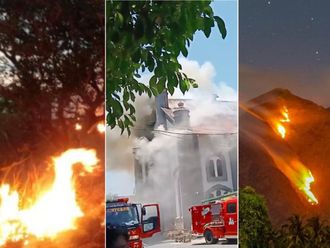Manila: Administrators of the former US air and naval bases in central Luzon were urged to work harder to attract more investors, sources told Gulf News.
“I can help get investors. Subic should not go bankrupt,” said former Senator Richard Gordon, a former administrator of the Subic Bay Metropolitan Authority (SBMA) which has overseen the transformation of the former Subic Naval Base in Olongapo, Zambales, into commercial use since 1991.
Gordon, Felicito Payumo, Fil Salonga, and Armand Arreza, who headed SBMA earlier, have altogether generated $8 billion (Dh29.4 billion) in investments and 90,000 jobs in Subic.
South Korea’s Hanjin Heavy Industries has invested $2 billion at Subic’s shipyards.
Roberto Garcia, incumbent SBMA chairman earlier said he wanted to develop tourism in Subic, but added the defence department has other plans at Subic’s airport.
SBMA chiefs are mandated by the law that created the Bases Conversion Development Authority (BCDA) to develop former US military bases to their most productive use, invite investors, create jobs, and raise taxes and duties for the national government, said an SBMA official who requested anonymity.
“Access for US warships and planes is not part of the law that created BCDA,” said the same source, adding as Subic gets poorer through lack of investment, it would be easier for the government to “temporarily allow central Luzon to earn from the entry of US ships at Subic and US planes at the former US Clark Air Base in Angeles, Pampanga (also in central Luzon).”
The growing presence of US warships in Olongapo and US planes in Angeles is due to the US-Philippines Visiting Forces Agreement which was ratified by Congress in 1998, the source explained.
On the third quarter of 2012, 70 US Navy visited Subic, up from 55 US ships in 2011, and higher than 51 US ships in 2010. USS Emory S. Land, a submarine support vessel has been a major presence of the US military in Subic this year.
More than 100 US planes use the runway of the former US Clark Air Base every month.
The Clark Development Authority has been in charge of transforming the area into commercial use.
US ships and planes have been refuelling and replenishing supplies in Subic and Clark.
Subic Bay faces the contentious South China Sea which is claimed wholly by China, Taiwan, and Vietnam, and in part of the Spratly Archipelago by Brunei, Malaysia and Philippines. Clark is more inland, also in central Luzon.
Although Pentagon and Washington have repeatedly said the US has no intention of having military bases in the Philippines, but Philippine government officials have confirmed US plans to have more access at Subic and Clark.
US warships, planes and personnel have been growing in other parts of the 10-member countries of the Association of Southeast Asian Nations (Asean), and Australia, which is near Asean.












